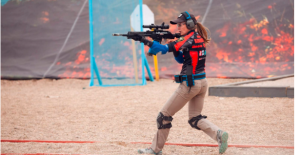Safety is paramount in every sport, but in shooting sports, the stakes are exceptionally high. The importance of ensuring safety while handling firearms cannot be overemphasized. Not only do athletes need to protect themselves, but they also have a responsibility towards their peers, spectators, and the broader community. This article aims to highlight the best practices in shooting sports safety and how athletes from other sports can learn from these protocols.
The Fundamental Four Rules of Gun Safety

Let’s dive right in by discussing the foundational principles that every person—be it an athlete, hobbyist, or casual shooter—should know and abide by:
- Treat Every Gun as If It’s Loaded. This is the cornerstone of firearm safety. Assuming a firearm is unloaded has led to countless accidental discharges.
- Never Point a Gun at Something You’re Not Willing to Destroy. This means always being aware of where the muzzle is pointing and ensuring it’s never aimed unintentionally.
- Keep Your Finger Off the Trigger Until You’re Ready to Shoot. This is a fail-safe. Even if other safety measures fail, this rule can prevent accidental discharges.
- Be Sure of Your Target and What’s Beyond It. Before pulling the trigger, ensure you’ve identified your target and are aware of any objects or persons that might be behind it.
Table of Contents
ToggleProper Maintenance and Handling
A well-maintained firearm is less prone to malfunction. Thus, regular cleaning and inspection are crucial. It’s also essential to understand the specific mechanics of each firearm type. A good example is the Colt 1911—a classic firearm whose value can sometimes be a topic of discussion. If you’re interested, you might be asking, “How much is a Colt 1911 currently worth?” But beyond its value, knowing its mechanisms, maintenance needs, and proper handling is paramount for safety.
Use of Safety Gear
In shooting sports, athletes always use safety gear, such as:
Eye Protection
High-impact glasses protect eyes from flying debris.
Ear Protection
Shooting can cause permanent hearing loss if ears aren’t protected.
Proper Attire
Closed shoes, hats, and high-necked shirts can prevent hot shell casings from causing burns or distractions.
Regular Training and Education

Consistent training under the guidance of experienced instructors ensures that athletes are always familiar with the best safety practices. Training sessions should include drills that mimic real-life situations to prepare athletes for all eventualities.
Secure Storage
When not in use, firearms should be securely stored away from unauthorized access. Safe storage means using gun safes, lock boxes, or any other security measure that keeps firearms away from children and those without proper training.
Applying These Principles to Other Sports
While the specific protocols vary, the underlying philosophy of safety in shooting sports can be beneficial across all athletic endeavors. Here’s how:
Always Start with Fundamental Safety Protocols
Just as we have the Fundamental Four in shooting sports, other sports should have their set of basic safety rules—like not diving into shallow water or always wearing a helmet when cycling.
Maintenance of Equipment
Just as guns need maintenance, so do other sports equipment. Tennis rackets, bicycles, and even running shoes require regular checks and maintenance to ensure they function safely.
Use of Appropriate Gear
From shin guards in soccer to gum shields in boxing, the right gear can prevent injuries. Always ensure equipment is up-to-date and in good condition.
Regular Training
Consistent training is as essential in basketball, soccer, or tennis as it is in shooting sports. Training keeps athletes at their best and reduces the risk of injuries.
Safe Storage of Equipment
This can be as simple as storing hockey sticks away from where someone could trip over them or keeping a baseball bat in a safe spot.
A Final Word

Shooting sports, like all activities, come with inherent risks. However, with the right precautions, the chance of accidents is significantly reduced. Safety isn’t about restricting fun or competitiveness—it’s about ensuring that every participant can enjoy the sport without fear of injury.
For further reading on safety in sports, the National Shooting Sports Foundation is a high authority and trustworthy source dedicated to promoting firearms safety. It’s always beneficial to stay updated with such institutions to ensure the highest standards of safety.
Note: When dealing with firearms or any other sports equipment, always seek expert guidance. The tips mentioned above are general best practices and may not cover all individual situations or needs.







